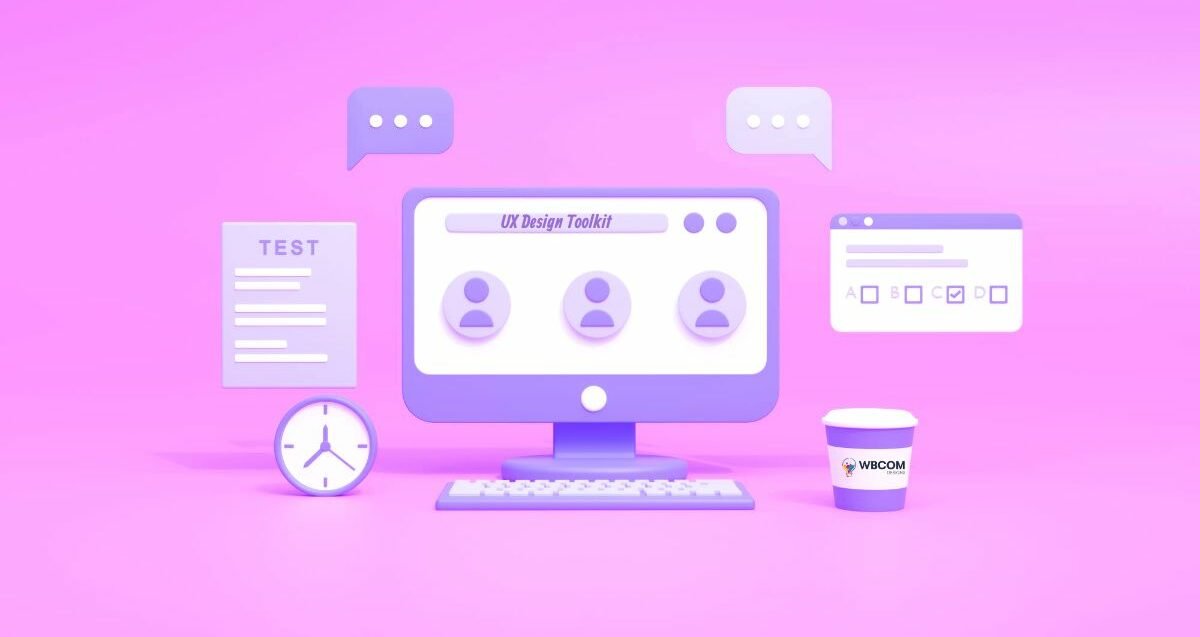People will forget what your product looked like, what it did, and even what it was called, long before they forget what they thought about it. If they thought it was clunky and counterintuitive, this thought will stay with them long after they forget the reason why they thought this.
They might just remember a negative or a positive experience long after they forget what your product does or what they used/needed it for.
Therefore, you need to design for a positive experience. While this is not simple, it can be made more seamless than you expect. How? Well, with the right UX design toolkit, of course. So, here are the top five types of tools that you need to have at your disposal (each for a different stage of the process).

Table of Contents
ToggleUX research tools
The first thing you need in your toolkit is the tools that you can use to research the user experience of your current audience. This way, you’ll discover insights into what you’re doing right or wrong. In some instances, these tools can even be used to research the experiences your customer base has with your competitors.
For this, you should probably find a usability tool like Maze. However, there are a lot of Maze alternatives out there that will serve you just as well. Just because a tool is an industry flagship, it doesn’t mean that you should be pigeonholed into using it.
Depending on your budget, you can take something significantly cheaper (as low as $25 per month) or take UserTesting for as much as $30k to $180k, depending on the contract.
What you need to do is combine two types of user observation. First, you need to ask them directly to rate your UI and their UX. For more accurate information, break these things down into separate elements and help provide actionable information on your future improvements.
At the same time, you need to be a bit more subtle and figure out how your product is performing when there’s (seemingly) no one to supervise it. With the right analytics and testing tools, you can get actual data on the performance of your platforms. Then, you compare these numbers to those of your competitors, industry standards, and user base expectations to get your results.
Also Read: Mastering Flextime: The Top 10 Apps Revolutionizing Flexible Work Schedules
Prototyping tools
Sometimes, a thing will sound like a good idea until you start constructing it. However, going through the process, even just to see the results, can be incredibly expensive and not worth it.
This is why you need prototypes and why prototyping tools are so amazing. You see, unlike with a physical product, making a software version of a prototype can be quite inexpensive. Using a set of templates and standard features, you get to create and test several prototypes and test them on users. This way, you see which venues are worth exploring and which don’t make too much sense.
So, the first major reason behind this is the visualization of ideas. The UI is all about the visuals and navigation. Regardless of whether it’s sleek, intuitive, simple, and clear, you can consider your UI to be a resounding success. Just keep in mind that the visuals that you may have in your head and the visuals in practice will be two different things, especially since your audience will use different screen sizes.
The most important purpose behind these prototyping tools is user testing. Previously, we’ve talked about the importance of getting user feedback. Well, there’s no feedback before they get to use the product. With a prototype, you can do this a lot earlier than you normally would.
Sometimes, you just need to validate your choices. These are scenarios in which you’re 100% sure that you’re making the right move; you just want one more confirmation before you fully commit to it. There’s nothing wrong with playing it safe, especially when you have the tool that can make this easy and inexpensive.
Consent management platform
Just a word of caution. If you do intend to test these prototypes on real users, make sure that they’re compliant with the rules and regulations of the jurisdiction that you’re under.
For this to work, you need to understand how jurisdictions work. You see, even as a US company, you’re under the jurisdiction of GDPR if some of your users are from Europe. This will always be the case with apps and platforms since not a lot of developers undergo the trouble of developing these tools just for the US market.
So, find yourself a GDPR compliance checklist for US companies and make sure you tick all the boxes. This way, you’ll avoid a world of legal trouble. Since you can do it without going too much out of your way, there’s no real reason to avoid doing so.
The right consent management platform can help you solve this problem early on and avoid any complications further down the line.
Later on, one of your main goals is to capitalize on your site, which is why you must get these tools long before you start advertising. This way, you can ensure that no regulations are breached and that your business is still working “in the green.”
There’s one more thing worth mentioning here, and that’s the user trust. While it may not be obvious at first, the truth is that user tryst drastically affects the way the users see your platform, which factors into your overall UX.
Also Read: 10 Best Sales Pipeline Software and CRM Tools Of 2024
UI and UX design toolkit
Now, we get to the actual work process. Tools like Sketch and Adobe XD can help you design the product that you’re aiming for. They’re there to help you get the visual aspect of the product in action, regardless if it’s a physical product or a digital asset that we’re talking about.
These tools allow you to create images and icons and choose (or even customize) typography. This way, you can figure out the visuals and the entire user end of the product quite seamlessly.
Don’t just assume that this is it since the visual aspects of the product come to the forefront in this stage. You need to pay just as much attention to the interaction design. This way, you get to see the way the animations within a digital interface will function. Most of the time, you’ll have tools to preview these interactive prototypes.
Now, combined with the insights you’ve gathered from the research tools and working on your prototypes, the development process shouldn’t hold too many surprises. You already have an idea of what your customers want and have a crude product version. Now, you have to test and refine it before you start mass-producing it.
One of the most important factors in choosing and optimizing these tools has to be the importance of integration with other tools. This is especially important if you have an entire team working on this. Integrating these design tools with a project management tool/collaboration platform can streamline the process.
Most importantly, by centralizing all your tools through integration, you’ll make asset management and transparency a lot easier.
Also Read: WCFM Review: For WordPress Multi Vendor Marketplace
User and usability testing tools
There’s some overlap between our first section and this last one. Namely, the majority of UX research tools can be used for user and usability testing, as well. Just don’t confuse these two tasks to be the same thing. You need to handle them both, and you need to handle them both right.
As always, the right way to conduct these tests is to test each segment. Without it, you’ll know that it doesn’t work but will never have an idea why. You need more than just a fact or a number – you need an insight.
With modern tools, user behavior analysis is fairly easy to conduct.
You can also combine some of these tools. You can check the usability of your prototype to get insights that you would, normally, have to wait a lot longer for.
The conditions and broader context of the way your platforms are used sometimes depend on the industry and field that you’re in. The UX on a newsletter is not the same thing as the UX on an online marketplace store.
The key thing to understand is that you’re competing within your industry and comparing your numbers to those of others within the industry. Cross-comparing will either leave you disappointed (when you have no reason to be) or overconfident (in a scenario where you can’t afford to be).
Having the right tool for every step of the process will make it easy to create a seamless UX
With the right tools on your side, each step of the process can be made simpler and more reliable. First, you need to do some research to get an idea of what kind of product you want to develop. Then, you make a prototype and ensure that you do everything in agreement with the regulations. In the next stage, you finally design the product. After that, you test and tweak it. Simple? Not as much, but seamless and streamlined.
By Srdjan Gombar

Veteran content writer, published author, and amateur boxer. Srdjan has a Bachelor of Arts in English Language & Literature and is passionate about technology, pop culture, and self-improvement. In his free time, he spends time reading, watching movies, and playing Super Mario Bros. with his son.
Interesting Reads
Guide to Web Design for Law Firms








